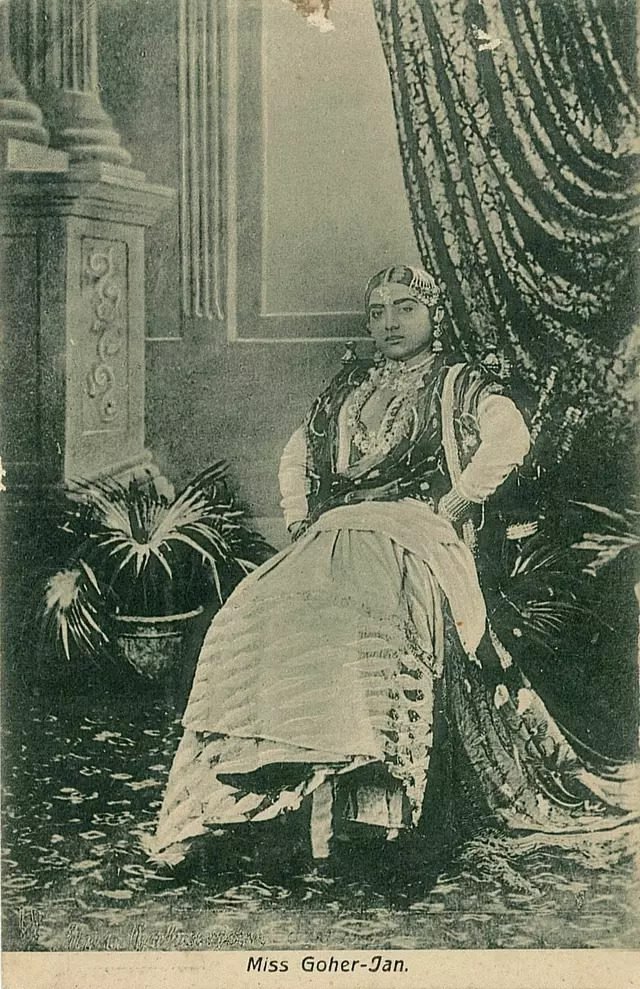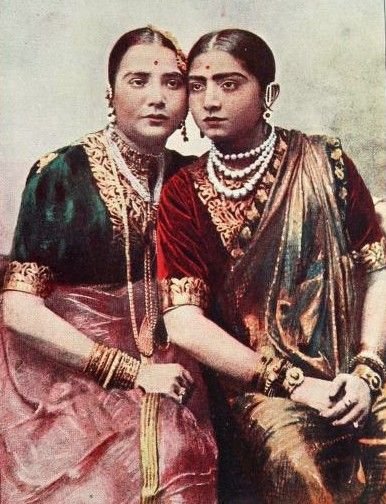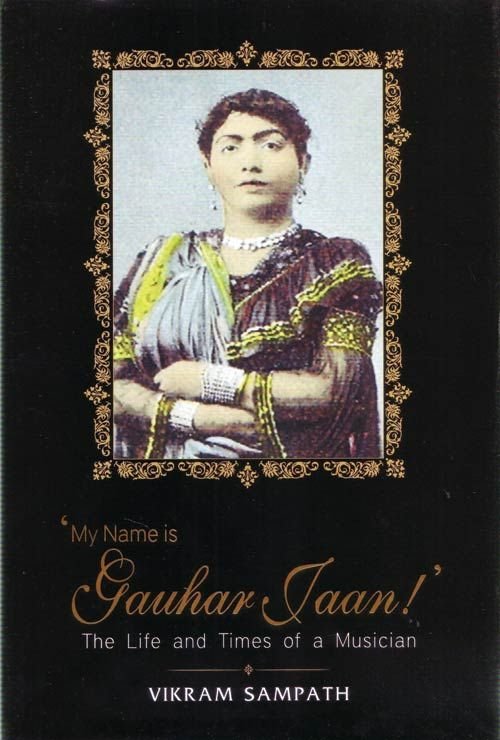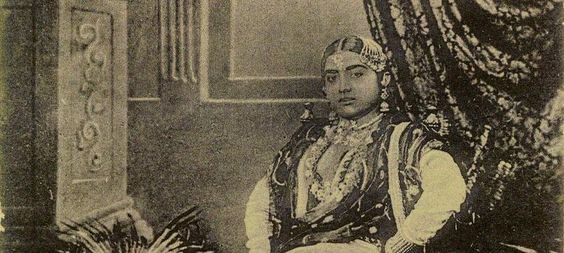THE GRAMOPHONE QUEEN: My Name is Gauhar Jaan

The golden nightingale of the golden age of Indian classical music, a radiant beauty draped in feisty opulence mesmerising the eyes, dropping jaws, getting the feets dance at her rhythms, tunes, songs and pioneering the epoch of recording in India and asserting the right of a performer to protect, own and exploit one’s identity, what we today call as the right of publicity, Gauhar Jaan was one of the most talented, popular, stunningly beautiful and exceptional classical musicians who has significantly contributed to the Indian art, music and dance heritage.

A life clad in luxury, Gauhar Jaan was one of the rarest wealthy women at the turn of the nineteenth century to be financially independent, robust and showed off the British her nerves of steel. Lightyears ahead of her time, she served as an epitome of feminist individualism whose grandeur and charisma made even the viceroy to bow before her, mistaking her as a royal queen.
Known as India’s trailblazing prima diva, she helped transform the struggling music industry with her pioneering feminism. Her 600 recordings laid the foundation for future artists, and her innovative practice of signing off her songs set a new standard for claiming ownership of one’s intellectual property.
Early life of an originator
Gauhar Jaan, originally named Eileen Angelina Yeoward, was born on June 26, 1873, in Azamgarh, within the United Provinces to an English Father and Armenian mother. Her parents’ unconventional marriage hinted at the rich cultural mix that would later define her. However, her childhood had its ups and downs. After her parents separated, young Gauhar and her mother, Victoria, were left to face life’s challenges on their own. Victoria, a gifted singer and dancer, converted to Islam, moved to Benaras, and adopted the name Badi Malka Jaan.

Victoria instilled in her daughter a deep passion for music, christening her Gauhar Jaan as they began their new life. In Banaras, Gauhar’s musical training commenced, laying the groundwork for what would later evolve in the city that led her admirers to fondly call her Gauhar Jaan ‘Kalkattewali’ (of Calcutta). Calcutta, a cultural hub attracting artists from across North India after Nawab Wajid Ali Shah’s exile, became the backdrop for Gauhar Jaan’s blossoming talent. Under her mother’s guidance, she absorbed the intricacies of Indian classical music, blending it with her Armenian roots. She underwent nearly a decade of intense training under the tutelage of some of the most renowned music and dance masters of the era, including Brindadin Maharaj, Ali Baksh, and Bhaiyya Ganpatrao. It was particularly within Nawab Wajid Ali Shah’s court at Metiabruz, that Gauhar Jaan’s talents truly thrived, gaining recognition and patronage from royals and aristocrats, and propelling her to fame.
At the mere age of 14, she astounded hearts with her melodious voice at the royal courts of Darbhanga Raj and her debut performance marked the beginning of a remarkable career, winning her the admiration and respect of all who heard her. From that moment, she was recognized as a true luminary in Hindustani music. However, despite the acclaim and adulation, Gauhar faced significant challenges throughout her life. At just thirteen, she endured a traumatic sexual assault, leaving her with deep physical and emotional scars.

Belonging to a group of female performers known as “Tawaifs,” who were once revered in high esteem within society, with a shift in societal perceptions, they became targets of defile stigma and acute discrimination. During the 19th and 20th centuries, this stigma grew even stronger, leading to the criminalization and persecution of the Tawaif community. But Gauhar Jaan was a woman who carved her own dignified destiny.
GRAMOPHONE and GAISBERG
When Frederick Gaisberg, the lead agent of Gramophone and Typewriter Limited in India, introduced the gramophone to the subcontinent, it was met with widespread superstition. Many feared that recording with the device could offend the gods or trap a singer’s voice in its horn. Critics argued that recording Indian classical music would compromise its authenticity. Most established artists, already secure in their reputations, were hesitant to risk their image for an unfamiliar technology. Gaisberg, however, recognized that the ambition he sought could be found in impoverished female performers, who were willing to take risks to support themselves. The Gramophone Company began inviting these women, offering a generous ₹3,000 for successful recordings.
It was one of these “lowly” nautch girls who revolutionised Indian classical music. Gauhar Jaan, adaptable and quick to learn, became the first female artist in the subcontinent to make a recording, skillfully condensing full-length compositions into the new three to four-minute disc format.
‘MY NAME IS GAUHAR JAAN’
Before other maestros could even come to terms with the idea of the phonograph, Gauhar Jaan eagerly accepted Gaisberg’s request to record a khayal in Raag Jogiya. Thus began her recording excursion with the company in the winter of 1902 in Calcutta. Gauhar Jaan went on to create an extraordinary discography of nearly 600 records in over 10 languages, including Bengali, Hindustani, Gujarati, Tamil, Marathi, Arabic, Persian, Pashto, French, and English. Her extensive musical repertoire covered a wide range of genres, from the intricate classical khayal to the vibrant folk thumri, encapsulating the rich diversity of India’s musical traditions.

Her recordings, made at 78 rpm, marked a pivotal moment in Indian music history, preserving her voice for future generations. Her iconic phrase, “My name is Gauhar Jaan,” immortalised her in history, leaving an indelible legacy. Such was her talent that she commanded fees between ₹1,000 and ₹3,000 for her performances, a significant sum in those days. This bold decision not only revolutionised the music industry but also challenged societal norms that restricted women’s roles in the public sphere. Every note she sang was imbued with profound emotion and passion, leaving a lasting impact on all who had the privilege to listen. She infused a new genre while singing at a pitch and tempo never heard before.
Gauhar Jaan’s sound mark, “My name is Gauhar Jaan,” at the end of each recording served not only as an identification tool for technicians but also as a powerful form of self-promotion. This seemingly simple tagline established her proprietary claim over her work, boldly asserting her identity and voice, laying the foundation for what is now recognized as the right of publicity—the performer’s right to protect, own, and exploit their identity.
While treasuring the integrity of the art, she skillfully adapted it to suit the cutting-edge technology of the time. Beyond the technical adjustments, it required immense bravery for a woman to sit in a hotel room filled with engineers and company representatives, daring to experiment with both music and societal taboos at a time when purdah (seclusion) was the prevailing norm.

TORCHBEARER OF PERORMER’S RIGHTS
In an era where intellectual property was a largely Western concept, Jaan’s assertion of ownership over her intangible creations was groundbreaking. Her actions were a testament to feminist individualism, far ahead of her time. Decades later, the issue of performers’ rights would surface in the case of Fortune Films International vs. Dev Anand, where the Bombay High Court controversially ruled that performances did not qualify as ‘work’ under the Copyright Act of 1957. This decision, widely criticised, highlighted the long-standing struggle for recognition of performances as creative art. It wasn’t until the Copyright (Amendment) Act of 1994 that Indian lawmakers finally acknowledged performers’ rights, a battle Gauhar Jaan had anticipated for nearly a century. Her pioneering stance on intellectual property and ownership challenged the prevailing norms, making her an extraordinary figure in the early 1900s.
Gauhar Jaan showed us that every performer imbues their art with a piece of their creative soul, and in an industry that often exploits talent for commercial gain, the identity, integrity, and economic benefit of the individual performer should never be sacrificed for profit or showmanship. By 1905, the pop sensation had her hand-painted portraits featured on Austrian matchboxes. She also embraced the postcard craze with such flair that other artists were often dubbed their city or town’s ‘Gauhar Jaan’ on postcards bearing their names.

SIX HORSE CARRIAGE RIDES at EDEN GARDEN
Gauhar Jaan, known for her flair and boldness, often took rides near Eden Gardens in her six-horse carriage. At that time, there was a ₹1,000 fine for commoners using carriages, as they were reserved for British and Indian royalty. Undeterred by the penalty, Gauhar Jaan willingly paid the fine, asserting her independence by continuing her carriage rides. In another display of her defiance, she demanded a dedicated train to Datia, where she was invited to perform. She arrived in grand style, accompanied by her entire entourage, including khansamas, a personal hakeem, washerman, barber, and numerous servants, all travelling together with her.
A SPENDTHRIFT FEAST
Gauhar Jaan’s extravagant celebration, where she reportedly unrestrainedly spent nearly 20,000 rupees on a grand feast to mark the birth of her cat’s litter. There’s also a tale about her hosting a celebration for the marriage of one of her cats. As a self-proclaimed cat lover, this whimsical and unexpected detail was the image of a woman in the 20th century, unapologetically indulging in her passions, leading a lavish life, earning her own income, and spending it on what brought her utmost joy.
A MILLIONAIRE SINGER and A FEARLESS WOMAN
Known for her flamboyance and fearless defiance of societal norms, Gauhar Jaan blazed a trail of authenticity and self-expression, inspiring others to embrace their unique talents. From her luxurious horse-drawn carriage rides in Kolkata to her lavish celebrations, she revelled in her celebrity status with unbridled exhilaration.

At her peak, she enjoyed special privileges, including a personal train for performances. Renowned for her extravagant style, she adorned herself with distinctive jewellery and was reputedly India’s first millionaire singer. Remarkably, she charged ₹3,000 per recording when 10 grams of gold cost just ₹20—a sum equivalent to around ₹1 crore per song today. Her legacy is a testament to the power of individuality and the courage to be and cherish oneself.
Gaisberg’s nearly nostalgic reflection on his recording experiences with her seems especially apt: “Her records were among the 600 that laid the strong foundation for our new venture… Each time she came to record, she surprised us with a new, increasingly elaborate gown.
“She never repeated her jewellery. Particularly striking were her delicate black gauze draperies, embroidered with real gold lace, arranged to reveal a bare leg and a bare navel. She was always impeccably dressed.”


